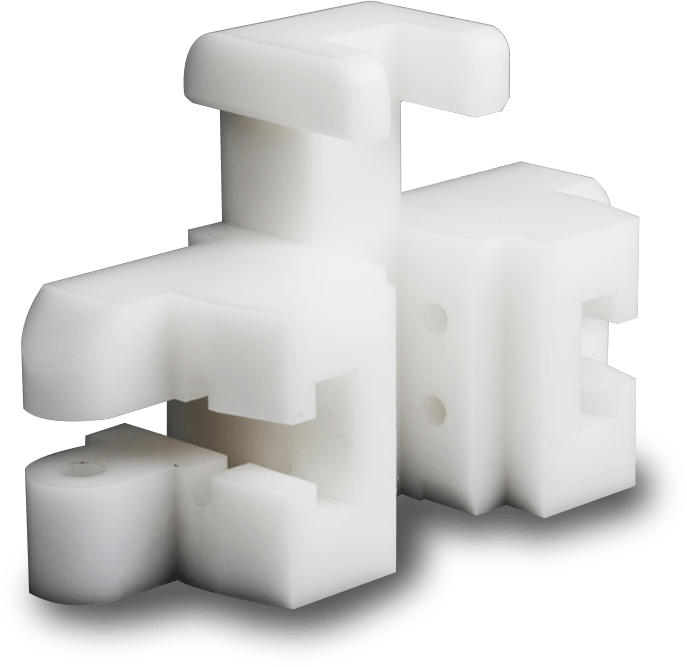When it comes to selecting materials for engineering and manufacturing projects, a common question arises: What are the key differences between UHMW vs Delrin? Understanding these materials can significantly impact project performance and success. Ultra High Molecular Weight Polyethylene UHMW vs Delrin are two popular thermoplastics that often come up in comparison, each boasting unique properties, advantages, and applications. This article explores the characteristics of UHMW vs Delrin, providing a clear comparative analysis to assist in your selection process.
Understanding UHMW: Properties and Applications
What is UHMW?
Ultra High Molecular Weight Polyethylene (UHMW) is a type of polyethylene with a very high molecular weight, typically exceeding 1 million g/mol. This structure gives UHMW its remarkable properties, making it ideal for various applications.
Properties of UHMW
High Abrasion Resistance: UHMW resists wear and tear, making it perfect for applications where friction occurs.
Low Friction Coefficient: It allows for smooth operation in systems like conveyors and sliding surfaces.
Impact Resistance: UHMW maintains high impact strength even in low temperatures, suitable for environments with sudden shocks.
Chemical Resistance: The material withstands a wide range of chemicals, including acids and solvents, making it useful in diverse industrial settings.
Moisture Resistance: UHMW does not absorb water, preserving its structural integrity in wet environments.
Applications of UHMW
Due to its unique properties, UHMW finds use in many industries, including:
Food Processing: Its non-toxic nature and ease of cleaning make it perfect for food contact applications.
Mining and Material Handling: The wear-resistant nature of UHMW is ideal for chutes, liners, and other components exposed to abrasion.
Medical Devices: Its biocompatibility and resistance to sterilization make it suitable for medical applications.
Marine Applications: UHMW is used in boat components and marine hardware because of its resistance to corrosion and moisture.
Common Uses of UHMW
In my professional experience, I have seen UHMW utilized in various applications, such as:
Sliding Bearings: Used in machinery where parts slide against each other.
Wear Strips: Employed in conveyor systems to protect other components from wear.
Bushings: Provides low-friction surfaces in various mechanical applications.
Packaging: Used in the food industry for conveyor belts and other equipment.
In summary, UHMW’s unique properties make it versatile across multiple industries, particularly where durability and low-friction performance are essential.
Discovering Delrin: Versatility and Benefits
What is Delrin?
Delrin, also known as acetal or polyoxymethylene (POM), is a thermoplastic polymer recognized for its high strength, stiffness, and excellent dimensional stability. It’s a versatile material commonly used in engineering.
Properties of Delrin
High Strength and Stiffness: Delrin offers excellent mechanical strength, suitable for parts under high stress.
Low Friction: It has a low friction coefficient, enhancing performance in sliding applications.
Dimensional Stability: Delrin maintains its shape and size under varying temperatures and humidity, essential for precision applications.
Chemical Resistance: While not as resistant as UHMW, Delrin withstands many chemicals and solvents.
Good Machinability: Delrin is easy to machine and fabricate into intricate shapes, making it a favorite among engineers.
Applications of Delrin
Delrin’s properties make it fit for a variety of applications:
Automotive Components: Used in fuel system components, gears, and bearings because of its strength and durability.
Consumer Products: Commonly found in items like zippers, knobs, and various household products.
Industrial Applications: Utilized in precision parts such as fittings, valves, and bushings.
Electronics: Often used in connectors and housings because of its insulating properties.

Comparative Analysis: UHMW vs Delrin
| Factor | UHMW | Delrin |
| Wear Resistance | Superior wear resistance | Lower wear resistance |
| Moisture Resistance | Excellent moisture resistance | Can absorb moisture |
| Strength | Lower strength | Higher tensile strength |
| Dimensional Stability | Moderate stability | Excellent stability |
| Machinability | Moderate | Easy to machine |
Overall, choosing between UHMW vs Delrin depends on your application’s specific needs. Understanding these strengths and weaknesses is crucial for making an informed decision.
| Property | UHMW | Delrin |
| Wear Resistance | Superior wear resistance | Lower wear resistance |
| Moisture Resistance | Excellent moisture resistance | Can absorb moisture |
| Strength | Lower tensile strength | Higher tensile strength |
| Dimensional Stability | Moderate stability | Excellent stability |
| Machinability | Moderate | Easy to machine |
| Temperature Resistance | Good thermal stability | Excellent thermal stability |
| Chemical Compatibility | Broad chemical resistance | Good, but not as extensive as UHMW |
| Cost | Generally lower cost | Typically higher cost |
| Applications | Food processing, mining, medical | Automotive, consumer goods, electronics |
Expert Insights and Common Misconceptions
In discussions with material scientists and engineers, I’ve encountered misconceptions about UHMW and Delrin. One common belief is that UHMW is always the better choice due to its high abrasion resistance. However, Delrin’s superior strength and machinability can make it a more suitable option for applications requiring precision and durability.
Addressing Myths
- Myth: UHMW is always more durable than Delrin.
Reality: While UHMW excels in wear resistance, Delrin outperforms in strength and stability for specific applications.
- Myth: All thermoplastics can be used interchangeably.
Reality: Each material has specific properties tailored to unique applications. Understanding these differences is essential for optimal performance.
Cost Considerations: Budgeting Your Material Choice
Pricing Factors for UHMW
The cost of UHMW can vary based on several factors:
Material Grade: Different grades of UHMW have varying properties and price points.
Thickness and Size: Larger and thicker sheets or parts cost more.
Market Demand: Supply and demand fluctuations can affect prices, especially in industries using UHMW in bulk.
Pricing Factors for Delrin
Similarly, the cost of Delrin is influenced by:
Grade and Type: Various grades can impact the price based on performance characteristics.
Fabrication Method: Machining or molding can increase overall costs, especially for custom parts.
Volume: Bulk orders often lead to discounts, impacting the cost per unit.
Cost Comparison Summary
Generally, UHMW is less expensive than Delrin. However, material choice should not rely solely on cost. Evaluating durability, long-term benefits, and application needs is essential for determining the most cost-effective solution.
Making the Right Choice: Factors to Consider for Your Project
Key Elements to Evaluate
Application Requirements: Identify the specific demands. Is wear resistance critical, or is strength a priority?
Environmental Conditions: Consider moisture, temperature, and chemical exposure.
Budget Constraints: Assess cost against potential durability and maintenance savings.
Machinability: If custom shapes are necessary, evaluate the machining ease and costs for each material.
Regulatory Compliance: Ensure the selected material meets industry standards, especially in food processing or medical applications.
Conclusion
Deciding between UHMW vs Delrin involves careful evaluation of each material’s properties, applications, and costs. Both materials have strengths and weaknesses, making them suited for different situations. By understanding your project’s needs and the characteristics of these materials, you can make an informed choice that leads to optimal outcomes.
In summary, whether you choose UHMW or Delrin, each material offers unique benefits that can enhance performance and durability. Thoroughly evaluate your needs and consult with material suppliers or experts to select the best option for your specific application. For more information, consider looking at industry standards or technical datasheets that can provide additional insights into both materials.
Featured client/products:
Glass Floors | Semi Truck Ramp | Glass Blocks| IT Companies Near Me | SEO Services Near Me | Steel Yard Ramp | Ramp for Loading Dock | Glass Flooring | Loading Dock Ramps | Portable Yard Ramp | Painters Near Me | Interior Painters Near Me




